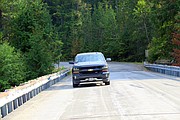Caution! This vehicle stops at all crick crossings
Any idea where to get a bumper sticker reading: CAUTION! THIS VEHICLE STOPS AT ALL CRICK CROSSINGS? I always slow down and often stop at any bridge or culvert that passes flowing water. Short of using the emergency flashers, I need to alert other motorists of my intentions. Fortunately this habit usually occurs while driving remote, lightly travelled logging roads, thus minimizing traffic hazards.
This long-standing practice fulfills two obligations for me. First of all, any forester knows bridges and culverts are expensive and require maintenance to function properly. Moreover, water must flow freely and allow for fish passage. It becomes second nature for me to look for obstructions or potential problems.
Secondly, I always carry a fly rod in my rig. A glance revealing promising water can easily turn into an unscheduled rod and reel survey.
One evening last summer while leaving one of my favorite cricks, I saved just enough daylight to enjoy sunset at the Union Road Bridge. As I slowly approached, a father and his young daughter walked across the bridge. Dad held a fly rod. Darn! He low-holed me for the prime fishing spot during the peak of the evening show.
The evening show, as I refer to it, is that magical time at dusk when caddis flies transform from their underwater life as rock hugging periwinkles. They drift to the surface and spend a few seconds as newly emerged adults fluttering to dry and test their unused wings. Helicopter pilots do much the same as they conduct the engine run-up before take-off.
While this entomological transformation occurs, trout anxiously poise themselves to quickly dart to the surface and grab these tasty bugs for their supper. The challenge for fly fishers is to have a fly on their tippet that closely resembles the adult caddis fly. If all goes well, magic happens at that moment.
If I couldn’t beat the other angler to the Bridge Pool, at least I would delay him with conversation.
As two anglers meeting for the first time with neither wanting to divulge any secrets, our chit-chat began pretty vaguely. “Pretty slow but I got a few.” “Yeah, me too, mostly small ones.” Fishing talk usually ends at this point closing with a wish for good luck. But we continued.
Without realizing the conversation would reach this degree of sharing, neither of us dared acknowledging what began emerging as a revelation. But he spilled the beans by mentioning a 12-inch cutthroat trout. In this small stream where the trout average about six inches, one measuring a foot-long deserves an episode on the TV program River Monsters.
I, too, hooked a 12-inch cutthroat only to watch the #14 barbless hook slip out of its jaw as I reached to pick up the fish. This self-release was just fine as I never keep a native westslope cutthroat trout, even where legal.
Our conversation continued. Attempting to not appear suspicious, I glanced down toward his footwear. It didn’t take a detective to recognize that I was possibly looking at the same wading boots that left the tracks in the sand bar near the big fish’s pool. Were we both talking about the same fish? Thanks to the ethic of catch-and-release fishing, perhaps we both experienced the satisfaction of sharing the same monster cutthroat trout.
Well, I had delayed him long enough. He rightfully earned dibs to the Bridge Pool during the evening show. Moreover, maybe he would hand the rod over to his daughter and let her catch a fish with a fly.
Until I find that bumper sticker, watch out for my rig blocking traffic on bridges and culverts crossing cricks.



